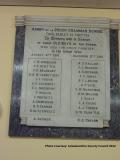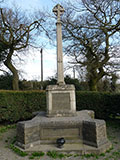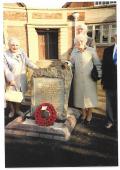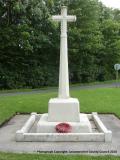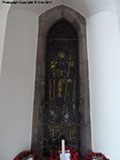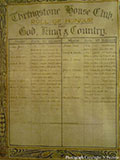Ordinary Telegraphist Alex James Turner, BRISTOL Z/5358
- Batt -
- Unit - Royal Naval Volunteer Reserve
- Section - HMS Paxton (Q.25)
- Date of Birth - 03/11/1897
- Died - 20/05/1917
- Age - 19
Add to this record?
If you have photographs, documents or information that can contribute to this record, you can upload here
ContributeSource: Michael Doyle Their Name Liveth For Evermore: The Great War Roll of Honour for Leicestershire and Rutland. He was the son of William John Turner, a domestic gardener, born 1857 in Burbage, Leics., and his wife Mary Turner (nee Black, married in the 3rd quarter of 1891 in the Melton Mowbray, Leics. district), born 1862 in Melton Mowbray, Leics. Alex James was born on the 3rd November 1897 in Coleorton, Leics., his siblings were, Wilfred, a schoolboy, born 1895, Frances Mary, a schoolgirl, born 1896 and Dorothy Sarah, born 1899, all his siblings were born in Coleorton, Leics., in March 1901 the family home was at Rectory Lodge, Coleorton Lount, Coleorton, Leics. In April 1911 Alec was a schoolboy and was residing in the family home at The Lodge, Cross Lane, Whitwick, Leics., together with his father, a domestic gardener, his mother and siblings, Wilfrid, a mechanical engineering apprentice, Frances, a schoolgirl, Dorothy, a schoolgirl and Ernest Robert, a schoolboy, born 1902 in Coleorton, Leics. The background relating to the circumstances in which Alex lost his life are as follows: On the 20th May 1917 HMS Paxton (Q.25) engaged an enemy submarine on the surface without result. Later in the day she was torpedoed and sunk at position 51. 23N. 11. 29W. in the Atlantic Ocean. The following day the 21st, 3 officers and 8 men were rescued by USS. Wadsworth, on the 26th, 4 men were rescued from a raft by SS. Dundrennan and another boat with 20 survivors reached the coast of Ireland on the 27th on May.
Source: Leicestershire War Memorials Project. Coalville Times article - Friday June 1st, 1917
Mr and Mrs W. Turner, of the Ashby Lodge, Gracedieu, have been notified by the Admiralty that the ship on which their son, Alec, was engaged as a wireless telegraphist, was sunk on May 20th, and that his name does not appear in the list of survivors. Much sympathy will be felt for the parents in the supposed loss of a most promising son. Alec Turner was only 19 years of age, and when he joined up had just completed his term as a student teacher at the Coalville Bridge Road School, where he was a great favourite with the children, and very popular with his fellow teachers. As a lad he attended the Thringstone Church of England School, and won a scholarship under the former headmaster, Mr E. S. Bealter, now of South Wigston. He attended Ashby Grammar School, where he had a very successful career, and adopting the teaching profession, was posted to the Coalville Bridge Road School. He joined the Forces about nine months ago, and after a few months’ training at the Crystal Palace, volunteered for service at sea on a patrol boat. He was at home on ’48 hours’ leave only on the Sunday as his ship went down on the following Sunday, and he then spoke of the dangerous nature of the work, but was in very cheerful spirits, and gave a thrilling account of his vessel having sunk a German submarine only a short time previously. Mr W. Turner, who is gardener to Mrs Booth, of Gracedieu Manor, has another son in the Forces, who has been over on leave this week.
Coalville Times article - Friday July 20th, 1917
Mr and Mrs Turner of the Lodge, Gracedieu, have now been officially notified of the death of their son, Alec. The report received from the Admiralty some weeks ago was that his ship had been sunk, and his name did not appear in the list of survivors. The authorities have now assumed his death. The deceased was on the threshold of a promising career in the teaching profession. He was very successful as a student at the Ashby Grammar School, and was a pupil teacher at the Coalville Bridge Road Council School, before he joined the Navy and became a wireless operator. His father is a gardener to Mrs Booth, of Gracedieu Manor. A memorial service for the deceased is to be held at the Thringstone Parish Church on Sunday next.
Coalville Times article - Friday May 21st, 1920
THRINGSTONE WAR MEMORIAL
UNVEILED BY COL. BOOTH AT THE PARISH CHURCH
A beautiful stained-glass window has been placed in St. Andrew’s Church, Thringstone, in memory of men from the parish who fell in the war, together with a brass tablet bearing all the names, and the unveiling was performed by Col. T. Booth at a special service last Sunday afternoon, when there was a crowded congregation, which included many relatives of the deceased soldiers.
The service was impressively conducted by the Vicar (the Rev. C. Shrewsbury) and opened with the singing of the hymn, “There is a Land of pure Delight.” Other hymns sung were, “O God our help in ages past,” “The Saints of God,” and “For all the Saints,” also the psalm, “The Lord is my Shepherd.”
The window, which faces the church entrance, depicts St. Alban, the first British martyr to die for the Christian faith, and inscribed, “Christ’s faithful soldier and servant unto his life’s end.”
The tablet by the side of the window bears the inscription, “To the greater glory of God, and in memory of the following who from this parish and congregation have given their lives for their country in the great war 1914 – 1919, this window is dedicated by the congregation and parishioners of St. Andrew’s.”
Here are 27 names, as follows:
1914
Pte. T. Jones, Durham Light Infantry.
1915
Pte. E. Hall, Leicestershire
Corp’l W. E. Moore, R.G.A.
Pte. I. Hall, Leicestershire
1916
Pte. E. Howe, Leicestershire
Sapper E. Robinson, Royal Engineers
Pte. L. Whitmore, Leicestershire
Pte. T. Squires, Leicestershire
Pte. M. Grainger, Leicestershire
1917
Pte. F. B. Bowler, Royal Dublin Fusiliers
Pte. R. Freeman, Leicestershire
Sapper H. Briers, Royal Engineers
A. J. Turner, telegraphist, Royal Naval Volunteer Reserve
Pte. J. Squires, Leicestershire
Pte. L. Haywood, Scottish Rifles
Corp’l W. Sykes, Leicestershire
Pte. T. Bailey, Royal Scots
1918
Corp’l J. Bancroft, Leicestershire
Rfn. G. W. W. Howe, Rifle Brigade
Pte. J. Gee, York and Lancaster
2nd Lieut. T. F. McCarthy, Loyal North Lancashire
Pte. S. R. Dring, Leicestershire
J. T. Fortnam, Able Seaman, Royal Naval Division
L.-Corp’l A. Griffin, Sherwood Foresters
Pte. J. Morley, Suffolk
Pte. H. Freeman, Leicestershire
Pte. H. Lakin, Leicestershire
At the foot appear the words: “Greater love hath no man than this, that a man lay down his life for his friends.”
Having unveiled the memorial, Col. Booth proceeded to the other end of the church and from the chancel steps addressed the congregation as follows:
“My friends, I have been entrusted with the very solemn, but to me, the very proud duty, of coming here to address you, the members of this congregation on the subject of the memorial, that beautiful brass tablet which I have just had the honour to unveil, and I can assure you all that I am fully alive to the responsibility which that has involved upon me, and I am also very appreciative of the honour which it has imposed upon me. I am sure that as you heard those names read out, you could not fail to have been impressed, as I was, with the fact that these precious lives came from every class and from all ranks. What you may not have realised altogether is the width and scope of their sacrifice. I will try to explain what I mean. Reading out those names, I first find mention of men who went out at the start, in 1914, to help to stem the first wild onslaught of the Germans before we were ready; when everything was unprepared. Think of that. Then we pass on to other names of men who gave their lives in 1915, in those dull days in the trenches, when everything seemed dark, and when we appeared to be hammering our heads against a stone wall. Then I find more names in 1916, men who died in the great Battle of the Somme, which lasted for many weeks, but in which their services were rewarded by the first ray of hope which seemed to come to the nation. Then more names I find in 1917, men who took part in those hammering blows which we may regard as the period during which the war reached its height, when the storm seemed to be at its worst. Then in those terrible days in the early spring of 1918, I find more names, when the nation strained well-nigh to breaking point in her brave endeavour to stave off the last despairing effort of the Germans to overwhelm us on the soil of France. Lastly, and to me the most pathetic of all, are some few names of men who fell just as the dawn was breaking, a few days before the Armistice. Well, I have given a brief account of how those names covered that scope I spoke of at first. What then do we owe these men? I do not know whether you, or I, or anybody can yet appreciate the magnitude of that debt, but certain it is, we can never repay. What are we to do then – what must we do? Well, I think we must see to it that these men are never forgotten; that their names are never forgotten. This beautiful brass tablet and memorial window are the proof we intend to give that they shall not be forgotten. I think we must do more than this; we must see that we explain to the new generation that is coming on – explain to them what this tablet means; show them the names, and as they get older and more able to understand, explain to them what it stands for, what we really owe to these men; that we owe to them the peaceful possession of our houses, the freedom of the countryside to-day, the honour of our women and the safety of our little children. I think that is the duty for us in the future, and they will carry it on long after we are no more. Then, finally, I want to say a word to the members of this congregation who are relatives of the fallen. I know that nothing I can say is any real comfort; nothing that anybody can say is of any real comfort; but it may afford you some consolation to know that we, your fellow countrymen, are determined that the names of those beloved ones are not forgotten, and that brass tablet and window stand for all time as a witness to the noble and unselfish example of those brave souls, and I hope when you leave this church after this beautiful service, that you will feel as I do, and as all this congregation do I am sure, that their sacrifice has not been in vain.”
After the Benediction, the service closed with the singing of the National Anthem.
Research undertaken and submitted by Andy Murby 16/11/2017
- Conflict - World War I
- Cause of death - Killed In Action Aboard Ship
- Unit - Royal Naval Volunteer Reserve
- Cause of death - KILLED IN ACTION
- Burial Commemoration - Plymouth Naval Mem., Devon, England
- Born - Coleorton, Leicestershire
- Enlisted - Plymouth, Devon
- Place of Residence - 7 Meadow Lane, Coalville, Leicestershire, England
- Memorial - ST. JOHN THE BAPTIST CHYRD. MEM., BELTON, LEICS
- Memorial - ST. ANDREW'S CHURCH, THRINGSTONE, LEICS
- Memorial - GRAMMAR SCHOOL MEM., ASHBY DE LA ZOUCH, LEICS
- Memorial - BRIDGE ROAD SCHOOL MEM., COALVILLE, LEICS
- Memorial - Coleorton War Memorial, Leicestershire

